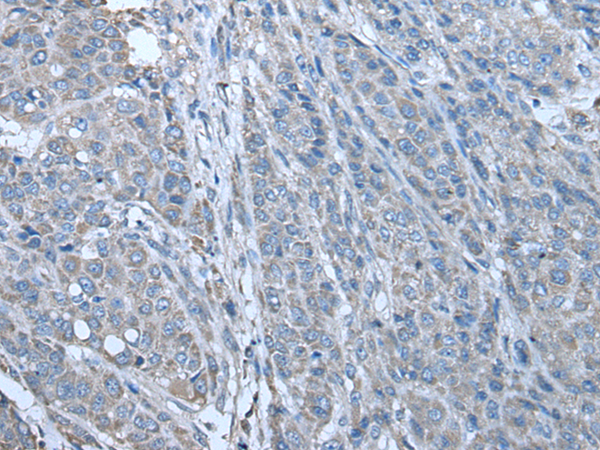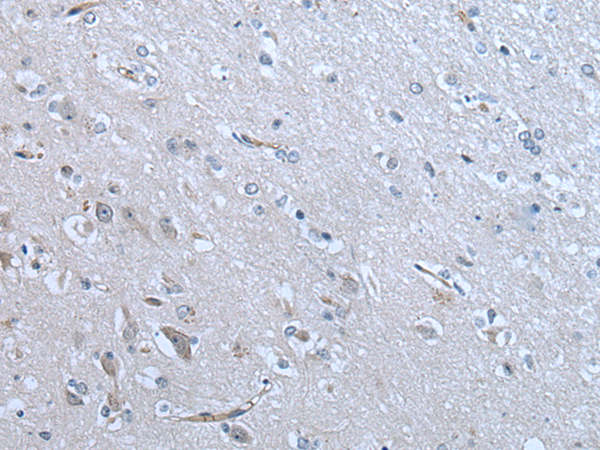

| WB | 咨询技术 | Human,Mouse,Rat |
| IF | 咨询技术 | Human,Mouse,Rat |
| IHC | 1/45-1/300 | Human,Mouse,Rat |
| ICC | 技术咨询 | Human,Mouse,Rat |
| FCM | 咨询技术 | Human,Mouse,Rat |
| Elisa | 1/5000-1/10000 | Human,Mouse,Rat |
| Aliases | ZAP; ZC3H2; ARTD13; PARP13; FLB6421; ZC3HDC2 |
| Host/Isotype | Rabbit IgG |
| Antibody Type | Primary antibody |
| Storage | Store at 4°C short term. Aliquot and store at -20°C long term. Avoid freeze/thaw cycles. |
| Species Reactivity | Human |
| Immunogen | Synthetic peptide of human ZC3HAV1 |
| Formulation | Purified antibody in PBS with 0.05% sodium azide and 50% glycerol. |
+ +
以下是关于ZC3HAV1抗体的3篇参考文献及其摘要:
---
1. **文献名称**: *ZC3HAV1 is a potent antiviral protein independent of its PARP activity*
**作者**: X. Guo, J. Ma, Y. Sun, et al.
**摘要**: 本研究揭示了ZC3HAV1(ZAP)通过结合病毒RNA抑制HIV-1复制的能力。作者使用ZC3HAV1抗体进行免疫沉淀和Western blot实验,证明其抗病毒功能不依赖其PARP结构域,而是通过招募RNA降解机制发挥作用。
2. **文献名称**: *SARS-CoV-2 ORF6 disrupts innate immune signaling by targeting cytoplasmic RNA sensing*
**作者**: Y. Zhang, T. Chen, C. Li, et al.
**摘要**: 该研究探讨了新冠病毒ORF6蛋白如何抑制宿主抗病毒反应,发现ZC3HAV1是病毒免疫逃逸的关键靶点。通过ZC3HAV1抗体的免疫荧光染色,揭示了ORF6与ZC3HAV1的亚细胞定位竞争,削弱其抗病毒活性。
3. **文献名称**: *TRIM25 enhances ZAP-mediated viral RNA degradation via ubiquitination*
**作者**: S. Hayakawa, H. Shiratori, K. Tokunaga, et al.
**摘要**: 研究报道了E3泛素连接酶TRIM25通过泛素化修饰增强ZC3HAV1的抗病毒功能。实验中利用ZC3HAV1抗体进行共免疫沉淀和蛋白互作分析,揭示了二者协同促进病毒RNA降解的分子机制。
---
以上文献均使用了ZC3HAV1抗体进行功能验证或机制研究,涉及抗病毒、宿主-病原体互作等领域。如需更多文献或具体细节,可进一步检索PubMed或相关数据库。
ZC3HAV1 (Zinc Finger CCCH-Type Antiviral Protein 1), also known as ZAP or PARP13. is a host-encoded protein critical in innate antiviral immunity. It belongs to the CCCH-type zinc finger protein family and functions as a RNA-binding protein that selectively targets viral RNAs, particularly those with high CpG content, for degradation. ZC3HAV1 exhibits broad-spectrum antiviral activity against diverse RNA viruses, including retroviruses, alphaviruses, and filoviruses, by recruiting exonucleases and the RNA degradation machinery through its N-terminal zinc finger domains. Additionally, it interacts with components of the ubiquitin-proteasome system to enhance viral restriction.
Antibodies against ZC3HAV1 are essential tools for studying its expression, subcellular localization, and mechanism in antiviral defense. They are widely used in techniques like Western blotting, immunofluorescence, and immunoprecipitation to investigate ZC3HAV1's role in viral infections, interferon signaling, and immune regulation. Research utilizing these antibodies has revealed ZC3HAV1's dual role in directly degrading viral RNA and modulating host immune responses, making it a potential therapeutic target. Commercial ZC3HAV1 antibodies are typically validated in human or murine models, aiding studies in virology, immunology, and host-pathogen interaction research.
×